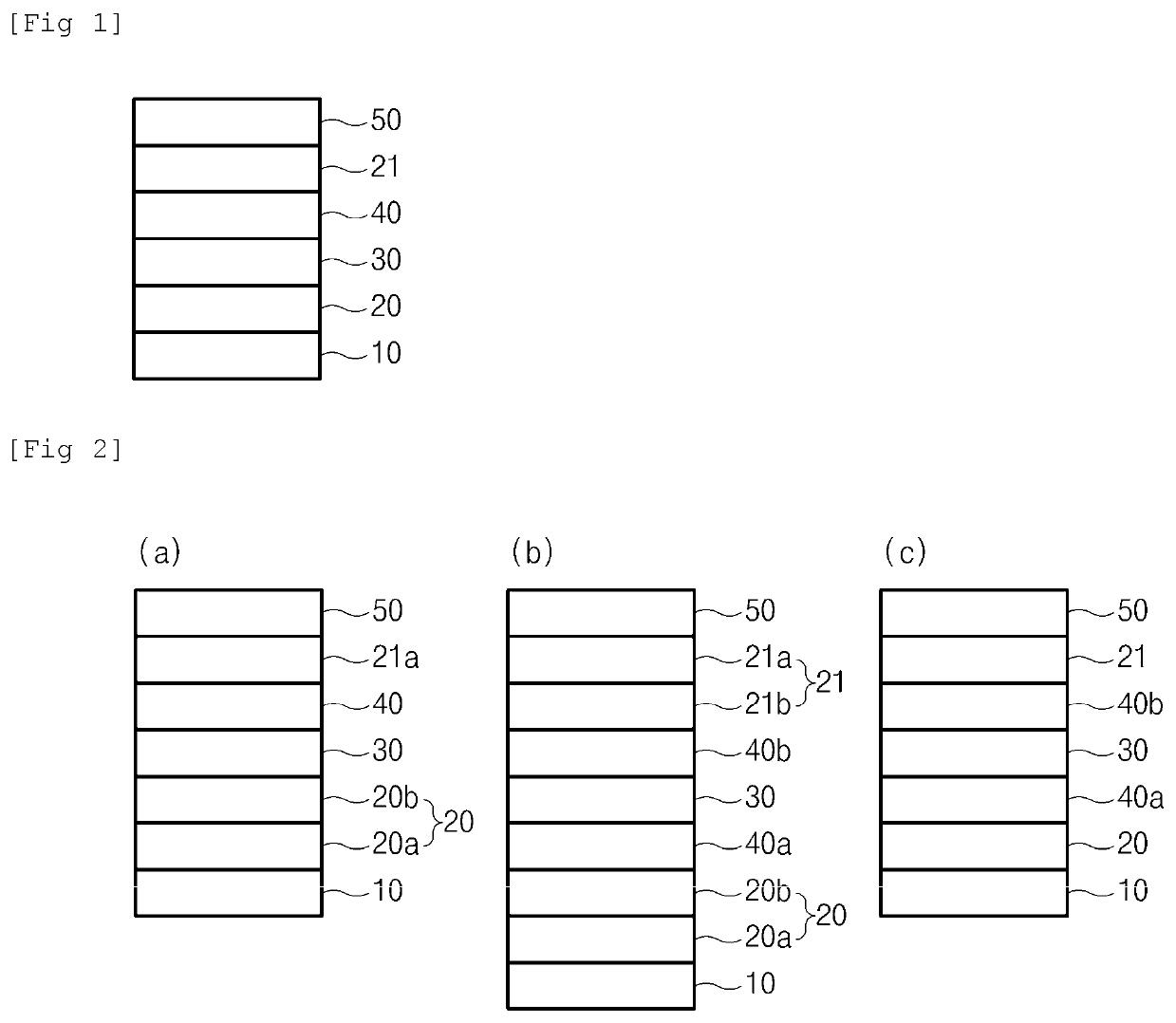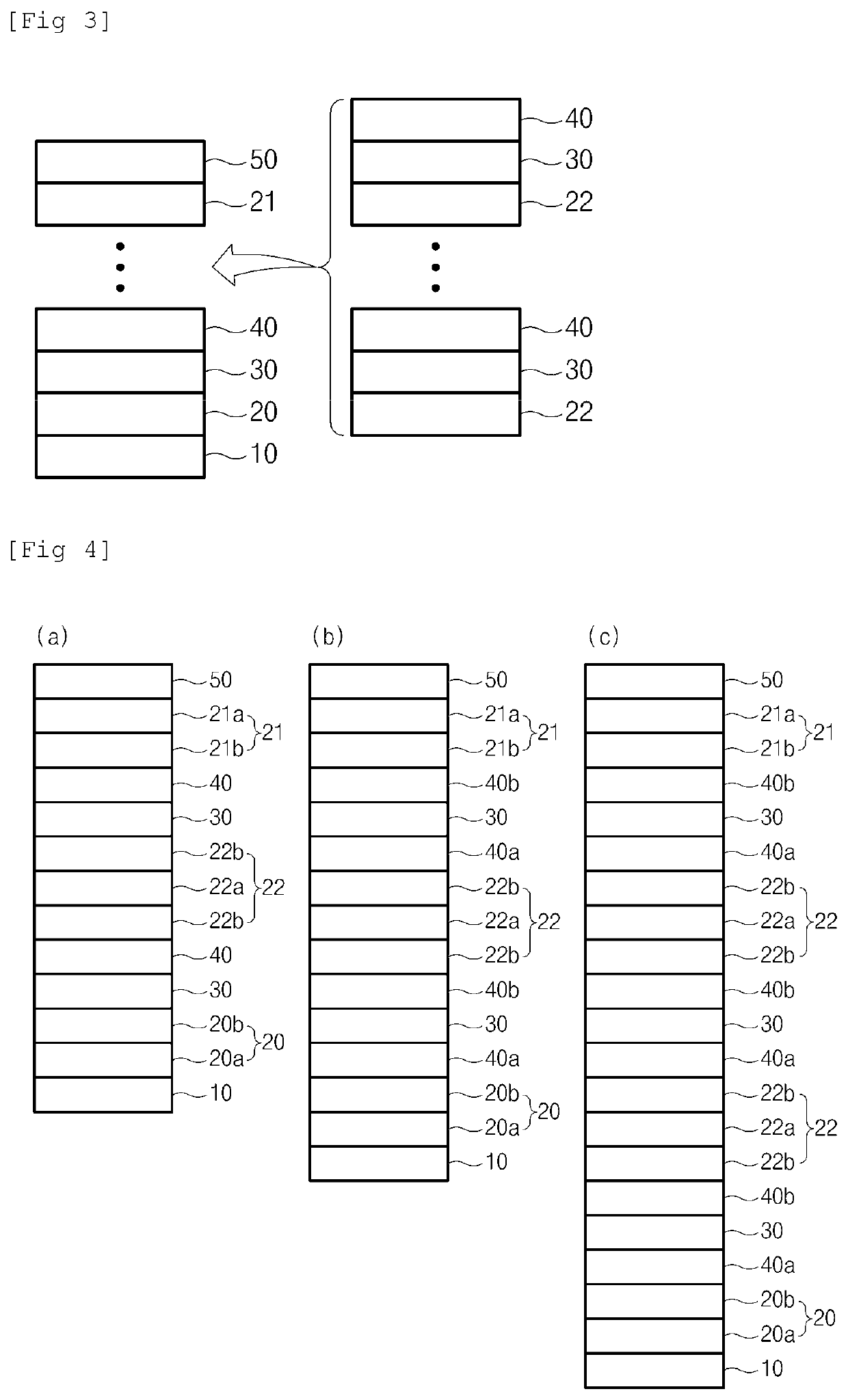Low-Emissivity Glass
a technology of low emissivity and glass, applied in the direction of coatings, etc., can solve the problems of poor durability, poor mechanical durability, poor durability, etc., and achieve the effects of stable sputtering, excellent deposition rate, and excellent handling
- Summary
- Abstract
- Description
- Claims
- Application Information
AI Technical Summary
Benefits of technology
Problems solved by technology
Method used
Image
Examples
example 1
[0053]Using a Magnetron sputter coater, low-emissivity glass was manufactured having a multi-layered coated film which has the composition and thickness shown in Table 1 below formed on a 6 mm transparent glass substrate.
[0054]A first dielectric layer (SiAlNx, x=1.3-1.5) was coated under a nitrogen / argon (nitrogen ratio: 40 vol %) atmosphere, and an absorption layer (NiCr alloy) was coated under an argon 100% atmosphere, and a metal layer (Ag) was coated under an argon 100% atmosphere. Thereafter, the absorption layer (NiCr alloy) was coated on the metal layer (Ag) under an argon 100% atmosphere, a second dielectric layer (SiAlNx, x=1.3-1.5) was coated under a nitrogen / argon (nitrogen ratio: 40 vol %) atmosphere, and a ZRN layer was coated as a coating layer on a nitrogen / argon (nitrogen ratio: 40 vol %) atmosphere using a metal target to manufacture low-emissivity glass.
example 2
[0055]Low-emissivity glass was manufactured in the same manner as in Example 1 except that a ZrN layer was coated as a coating layer under a nitrogen 100% atmosphere using a metal target.
TABLE 1ExamplesFilm type (film thickness: nm)1Glass / SiAlNx (30 nm) / NiCr(0.3 nm) / Ag(10 nm) / NiCr(0.2nm) / SiAlNx(30 nm) / ZrN N2 40%, 5 nm)2Glass / SiAlNx(30 nm) / NiCr(0.3 nm) / Ag(10 nm) / NiCr(0.2 nm) / SiAlNx(30 nm) / ZrN(N2 100%, 5 nm)
experimental example
[0058]The physical properties of the low-emissivity glass which was obtained in each of Examples and Comparative Examples were measured according to the following method, the results are shown in Table 3 below.
[0059]Moisture Resistance
[0060]One specimen coated with the low-emissivity glass manufactured in each of Examples and Comparative Examples was prepared to a size of 100×100 mm, and then placed in a constant temperature and humidity room (relative humidity 80±10%, temperature 30±2° C.). After 24 hours of curing, the specimen was taken out at 1-day (24 hours) intervals and water was removed therefrom with a cloth to determine whether the specimen satisfies the size and number of a pinhole (ϕ) and the following 1) to 3).
[0061]1) 4.0 mm ϕ more than one not allowed
[0062]1) 2.0 mm ϕ more than three not allowed
[0063]3) Front small pinhole not allowed
[0064]Scratch Resistance
[0065]1) General
[0066]One specimen coated with the low-emissivity glass manufactured in each of Examples and Com...
PUM
| Property | Measurement | Unit |
|---|---|---|
| thickness | aaaaa | aaaaa |
| thickness | aaaaa | aaaaa |
| thickness | aaaaa | aaaaa |
Abstract
Description
Claims
Application Information
 Login to View More
Login to View More - R&D
- Intellectual Property
- Life Sciences
- Materials
- Tech Scout
- Unparalleled Data Quality
- Higher Quality Content
- 60% Fewer Hallucinations
Browse by: Latest US Patents, China's latest patents, Technical Efficacy Thesaurus, Application Domain, Technology Topic, Popular Technical Reports.
© 2025 PatSnap. All rights reserved.Legal|Privacy policy|Modern Slavery Act Transparency Statement|Sitemap|About US| Contact US: help@patsnap.com


